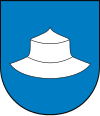 Alternate names: Kłobuck [Pol], Klobutzk [Yid, Rus], Klobutzko [Ger], Kłobucko, Klobutsk, Russian: Клобуцк, קלובוצק-Hebrew. 50°54' N, 18°56' E, 11 miles NW of Częstochowa. 1900 Jewish population: 1,027. Yizkors: Sefer Klobutsk; mazkeret kavod le-kehila ha-kedosha she-hushmeda (Tel Aviv, 1960) and Mayn shtetl Klobutsk: dermanungen (Stockholm, 1973). This town in Poland with 13,254 inhabitants in 2004 in the Silesian Voivodeship is the capital of Klobuck County. Before WW II, the city had a Jewish community of about 2,000 persons most of whom were killed during the German occupation in WWII. Map. camp outside Klobuck was called Podgorz. photo of Jewish refugees near Klobuck. [June 2009]
Alternate names: Kłobuck [Pol], Klobutzk [Yid, Rus], Klobutzko [Ger], Kłobucko, Klobutsk, Russian: Клобуцк, קלובוצק-Hebrew. 50°54' N, 18°56' E, 11 miles NW of Częstochowa. 1900 Jewish population: 1,027. Yizkors: Sefer Klobutsk; mazkeret kavod le-kehila ha-kedosha she-hushmeda (Tel Aviv, 1960) and Mayn shtetl Klobutsk: dermanungen (Stockholm, 1973). This town in Poland with 13,254 inhabitants in 2004 in the Silesian Voivodeship is the capital of Klobuck County. Before WW II, the city had a Jewish community of about 2,000 persons most of whom were killed during the German occupation in WWII. Map. camp outside Klobuck was called Podgorz. photo of Jewish refugees near Klobuck. [June 2009]
US Commission No. AS 136
Klobuck is located in Czestochowski (Czestochowa) at 50°55' 18°56', 17 km from Czestochowa. Cemetery location: Szkolna St., E from street about 300 m. Present town population is 5,000-25,000 with no Jews.
- Town: Urzad Miasta i Gminy pl. Obroucow Pokoju 13, tel. 2661.
- Regional: Wojewodzki Konserwator Zabytkow, 47-217 Czestochowa 1, ul. Domagelsluch 2, tel. 49-745.
Jon Pawel Woronczak, Sandomierska St. 21 m. 1, 02-567 Warszawa, tel. 49-54-62 completed survey. Woronczak and Jeny Woronczak visited the site in 1986. No interviews.
